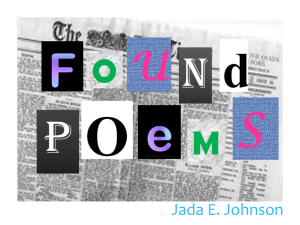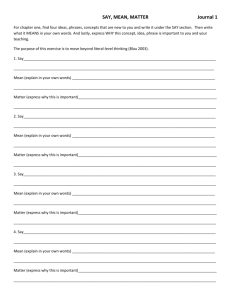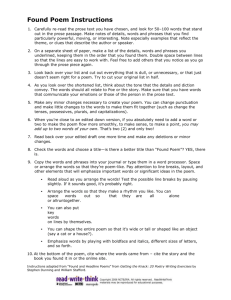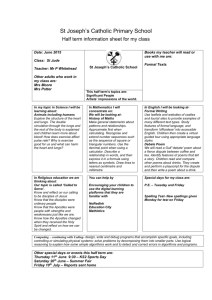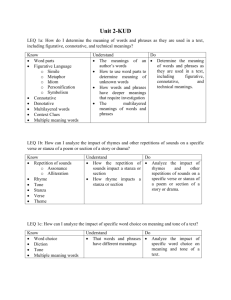What Is a Unit of Study
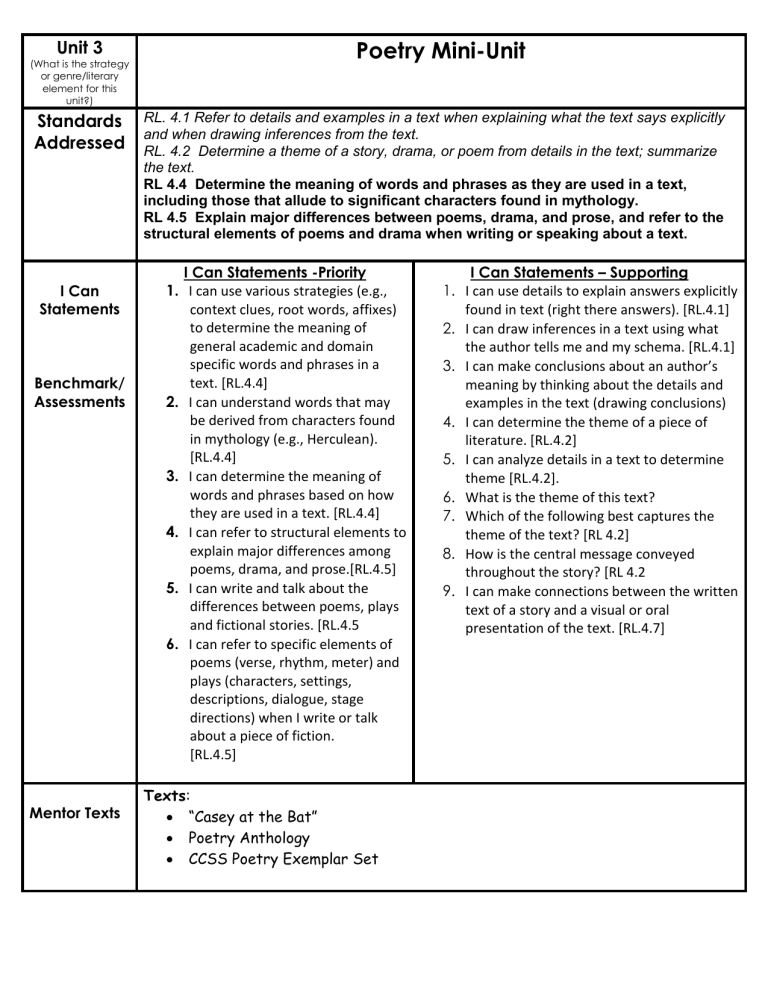
Unit 3
(What is the strategy or genre/literary element for this unit?)
Standards
Addressed
Poetry Mini-Unit
RL. 4.1 Refer to details and examples in a text when explaining what the text says explicitly and when drawing inferences from the text.
RL. 4.2 Determine a theme of a story, drama, or poem from details in the text; summarize the text.
RL 4.4 Determine the meaning of words and phrases as they are used in a text, including those that allude to significant characters found in mythology.
RL 4.5 Explain major differences between poems, drama, and prose, and refer to the structural elements of poems and drama when writing or speaking about a text.
I Can
Statements
Benchmark/
Assessments
Mentor Texts
I Can Statements -Priority
1.
I can use various strategies (e.g., context clues, root words, affixes) to determine the meaning of general academic and domain specific words and phrases in a text. [RL.4.4]
2.
I can understand words that may be derived from characters found in mythology (e.g., Herculean).
[RL.4.4]
3.
I can determine the meaning of words and phrases based on how they are used in a text. [RL.4.4]
4.
I can refer to structural elements to explain major differences among poems, drama, and prose.[RL.4.5]
5.
I can write and talk about the differences between poems, plays and fictional stories. [RL.4.5
6.
I can refer to specific elements of poems (verse, rhythm, meter) and plays (characters, settings, descriptions, dialogue, stage directions) when I write or talk about a piece of fiction.
[RL.4.5]
Texts:
“Casey at the Bat”
Poetry Anthology
CCSS Poetry Exemplar Set
I Can Statements – Supporting
1.
I can use details to explain answers explicitly found in text (right there answers). [RL.4.1]
2.
I can draw inferences in a text using what the author tells me and my schema. [RL.4.1]
3.
I can make conclusions about an author’s meaning by thinking about the details and examples in the text (drawing conclusions)
4.
I can determine the theme of a piece of literature. [RL.4.2]
5.
I can analyze details in a text to determine theme [RL.4.2].
6.
What is the theme of this text?
7.
Which of the following best captures the theme of the text? [RL 4.2]
8.
How is the central message conveyed throughout the story? [RL 4.2
9.
I can make connections between the written text of a story and a visual or oral presentation of the text. [RL.4.7]
Question Stems,
Comprehension
Strategies, and
Formative
Assessments
1.
Question Stems
1.
What do you do when you come to words or phrases you do not know? (use context)
2.
What does the word ________ mean in this sentence?
3.
Can you read the words or sentences around the word to help you determine its meaning?
4.
What does the phrase _________ mean?
5.
What strategies can you use to help you find the meaning of the word?
6.
In this sentence, the word ________ means _________.
7.
Why do you think the author used this word (mythology term) to describe ________?
8.
Can you tell me what is different about these kinds of texts? What is the same?
9.
This selection can best be described as __________.
10.
Can you show me a verse in this poem?
11.
Who are the major characters in the play/drama?
12.
Can you explain the difference between a poem and a selection of prose?
13.
Find an example of how the author uses rhythm in the poem.
14.
Where is this drama set?
15.
Explain the differences between a poem and a drama.
16.
Can you show me an example of a verse, rhythm, and/or meter in this poem?
17.
What does the author mean when he/she says ____?
18.
Which specific details in the text lead you to that conclusion?
19.
What can you infer from what you have read so far?
20.
Can you give specific examples from the text that support your thinking?
21.
What is the main idea of this poem/drama/ story?
22.
Which of the following best captures the theme of the text?
23.
How are the story and the visual presentation (picture, drawing, video) the same?
24.
Does the presentation accurately reflect the story?
Formative Assessments Reading Strategies
Solving
Words
Maintaining
Fluency
Synthesizing Analyzing
Vocabulary
Acquisition and Use
L.4.4- Multiple Meaning Words: Determine or clarify the meaning of unknown and multiplemeaning words and phrases based on grade 4 reading and content , choosing flexibly from a range of strategies.
I can identify words and phrases that may have multiple meanings and find ways to determine which meaning is appropriate in a particular sentence.
L.4.4b- Affixes and Roots: Use common grade-appropriate Greek and Latin affixes and roots as clues to the meaning of a word (e.g., telegraph, photograph, autograph.)
I can determine the meaning of a word by using the affix or root.
L.4.5- Figurative Language: Demonstrate understanding of figurative language, word relationships, and nuances in word meanings.
I can recognize and explain figurative language, word relationships, and the nuances in word meanings.
L.4.5c- Synonyms and Antonyms: Demonstrate understanding of words by relating them to their opposites (antonyms) and to words with similar but not identical meanings (synonyms).
I can demonstrate my understanding of words by relating them to their synonyms and antonyms.


